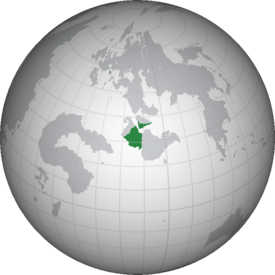Liberto-Ancapistan
This article is incomplete because it is pending further input from participants, or it is a work-in-progress by one author. Please comment on this article's talk page to share your input, comments and questions. Note: To contribute to this article, you may need to seek help from the author(s) of this page. |
Federal Republic of Liberto-Ancapistan Komaria Federale a Libertarya-Ancapistan | |
|---|---|
| Motto: "Azadî yan mirin" "Freedom or Death" | |
| Anthem: "Graveyard of Conquerors" | |
 Location of Liberto-Ancapistan | |
| Capital and largest city | Liberty City |
| Official languages | Basaquese, Santian |
| Recognised regional languages | Old Farstani, Fayrean, Mhertag |
| Ethnic groups | Basaquastanians, Santians, Fayreans, Mhertag |
| Demonym(s) | Liberto-Ancapistanian |
| Government | Federal parliamentary republic |
• Chancellor | Casimir Bergen |
• Vice-Chancellor | Sabah Shamoud |
| Legislature | Parliament |
| Senate | |
| House of Commons | |
| Establishment | |
• Formation of Liberto-Ancapistanian Alliance | 12th April 1944 |
• Unification of Liberto-Ancapistan | 21st March 1955 |
| Area | |
• Total | 1,450,077 km2 (559,878 sq mi) |
| Population | |
• 2025 estimate | 68,845,000 |
• 2018 census | 67,684,853 |
• Density | 47.48/km2 (123.0/sq mi) |
| GDP (PPP) | 2025 estimate |
• Total | 3.9417 trillion Rovas |
• Per capita | 57,255 Rovas |
| GDP (nominal) | 2025 estimate |
• Total | 4 trillion Rovas |
• Per capita | 58,101 Rovas |
| Gini (2025) | 54.1 high |
| HDI (2025) | very high |
| Currency | Fiat (LAF) |
| Time zone | UTC-6 |
| Date format | dd-mm-yyyy |
| Driving side | left |
| Calling code | +55 |
| ISO 3166 code | LTA |
| Internet TLD | .la |
Liberto-Ancapistan (Basaquese: Libertarya-Ancapistan), officially the Federal Republic of Liberto-Ancapistan, is a transcontinental nation spanning southern Evrosia and overseas Autonomous Territories in western Evrosia, Elisia, Antartica and Takaria. Situated primarily across the islands of Promeridona and Santia, it covers an area of 1,450,077 square kilometres (559,878 sq mi) with a population of 68.8 million in 7 constituent Provinces and 3 Autonomous Territories. Liberto-Ancapistan borders the Velika Tzarska Empire, the Imperiale Arabic Union, Baccara, Hockeyyekcoh and Aether Inc. in Evrosia, Alkamistan in Takaria, Northshires in western Elisia and Cannonio as well as the Super Best Dutch Empire in Antartica. It is a member of the United Federation of Telrova. Liberto-Ancapistan is a federal parliamentary republic with its capital in Liberty City, the country's largest city and main economic centre; other major urban areas include Sades, Compacipo, Dewisburgh, Port Rand and Orafars.
Etymology
The English name Liberto-Ancapistan is an anglicisation of the Basaquese Libertarya-Ancapistan. This is derived from Liberto-Ancapistan's predecessor, the Liberto-Ancapistanian Alliance (Basaquese: Tifaqa Libertari-Ancapistani), which itself was derived from member states Libertaria and Ancapistan. The former's name was originally a Santian exonym, used to describe the area of Basaquastan outside the Santian Empire - a 'free land'. The latter's name, meaning 'land of the Ancapi' in classical Basaquese (also called classical Nizmstani), refers to the Ancapi, a tribe of the Kimia Culture which existed during the last centuries of the 1st millenium BCE.
History
Prehistory and Ancient Liberto-Ancapistan (before the 6th century BCE)
Archaeological evidence at Lake Mergiri indicates that modern humans have inhabited Promeridona since at least 50,000 BCE. Rock art found in the Res Hills and Sikandin Massif has been dated to 30,000 BCE and 26,000 BCE respectively.
Agriculture first emerged in Liberto-Ancapistan c. 8,500 BCE, around the Cemsor Valley in modern-day Ancapistan Province. The first crops to be domesticated, independently of other areas of agricultural development, were rice and chickpeas. In northern Basaquastan, Promeridonan wheat had been domesticated by 6,000 BCE. The development of agriculture led to the creation of increasingly large settlements. The first walled city in modern-day Liberto-Ancapistan, Rayek, dates to c. 3,500 BCE and was followed in the succeeding centuries by the emergence of several cities around the Cemsor Valley, forming the Cemsor River Civilisation. These walled cities involved stratified social classes and were ruled from at least 3,000 BCE by individual monarchs. During this period, a system of logographic writing, Kisin, developed, initially written only on bones. This was expanded to clay tablets c. 2,750 BCE. The apparent lack of large temple structures and prevalence of oracle-bones suggests that the Cemsor River Civilisation did not involve organised religion, with the localised spirit-worship of later centuries already existing in some form. In the centuries following the development of Kisin the Cemsor River Civilisation's city-states were replaced by larger hegemonic Kingdoms, with the entire Cemsor Valley being briefly united by King Akal of Cibedar in 2,400 BCE.
Between 2,100 and 1,900 BCE most cities in the Cemsor Valley were abandoned in a total civilisational collapse. The reason for this large-scale abandonment is disputed, but modern research suggests that the region underwent significant localised climate-change during the period. Decreased precipitation levels may have caused large-scale drying and desertification in the Cemsor Valley, eventually making the maintainance of large urban cities unsustainable.
Despite the collapse of the Cemsor River Civilisation, Kisin survived in smaller settlements. Areas connected by trade to the Cemsor River Civilisation, most notably western Libertaria, were less affected by drying and continued on. By middle of the 2nd millenium BCE the city of Padisra in Libertaria had grown to have a population of at least 30,000, and had become the centre of a centralised Kingdom. In north-western Basaquastan, a large number of towns containing Kalars (fortified stone towers used for grain storage) had sprung up, eventually being united under the town of Great Pesh. The hereditary leader of Great Pesh was called 'Emir', a title which would quickly spread to become the most common title of Basaquastanian monarchs. In the following centuries several other Kingdoms grew across both Basaquastan and Upper Santia, creating a widely literate interconnected ancient world.
Classical Liberto-Ancapistan (6th century BCE – 411 CE)
In the 6th and 5th centuries BCE, with increasing political and social complexity elsewhere, state power within the Cemsor Valley emerged for the first time since the decline of the Cemsor River Civilisation. This took place with the formation of the Emirate of Nizmstan in 510 BCE, a polity which grew outward from the capital of An-Alqam to cover the entire Cemsor basin. Due to its high population density and many urban centres, Nizmstan was quickly established as a major power in the Basaquastan region and was responsible for the codification of a new abugida script, Nivin, created to establish a single writing system after many localised varieties of Kisin had emerged in the preceding centuries.
Between 387 and 245 BCE, the Emirate of Nizmstan conquered all of Basaquastan except for Farstan in the north-west. Adopting the name 'Emirate of Great Nizmstan', this Empire and Farstan formed the basis for the specific borders of Basaquastan used to this day. Great Nizmstan developed a system of government in which the Emirate was divided into over a dozen Sub-Emirates, ruled by appointed local leaders known as Sub-Emirs. These Sub-Emirs were responsible for raising tax and administrating their territories, but had no control over military affairs.
During the ascendancy of Great Nizmstan, the Nivim script replaced Kisin as the primary system of writing in Basaquastan, and was modified to create the Santian script outside the Empire's borders. The spoken language of the Cemsor Valley, Classical Basaquese, also supplanted local dialects as an elite language during the period, for the first time granting Basaquastan a single linguistic identity (though Farstan was not included at the time). The several centuries of Great Nizmstani rule in Basaquastan also facilitated an unprecedented increase in international trade, with goods from as far as eastern Tagrae and Elisia being found in cities and towns alike.
In the early 200s CE, three successive Shahs of Orafars, Piro-Vidama, Ariaspes, and Artaynte, united Upper Santia under a single ruler. In 240, the successful Shah Artaynte was declared 'Padishah of all Santia', establishing the beginnings of the Santian Empire. At the time, however, the new Santian state remained in a low position to Great Nizmstan, and in 244 Artaynte made a pilgrimage to the larger Emirate to join the League of Eshbara, an alliance formed by Abdul Aman III of Great Nizmstan to increase Nizmstani influence over Farstan and Santia.
In 285, Basaquastan was shook by the violent eruption of its largest mountain, Mount Birrin. The blast, estimated at VEI 6, caused thousands of immediate deaths and wider climate effects which were far more damaging. Ash blanketed fields across southern Basaquastan, carried by wind, and the mass ejection caused a volcanic winter. These combined to cause an event known as the Long Famine, a famine effecting 3 successive harvests in Basaquastan and causing mass death and peasant rebellion. In 287, a peasant rebellion in the Cemsor Delta seized An Alqam, causing the collapse of central authority and the dissolution of the Great Nizmstanian Empire. In what became known as the Burning Sky Period, newly independent Sub-Emirs fought over the disintegrating Empire with rapidly shifting areas of control and widespread death. The Long Famine had had a lesser effect on northern Basaquastan and Upper Santia, allowing Farstan and Santia to retain control over their territories.
Santian Empire (411 – 1840)
In 411, Padishah Ashur of Santia led an invasion fleet to Farstan. Tension had been building between both states over the northeast coast of Basaquastan, a key area in local trade which Farstan had annexed and placed heavy taxes on. Ashur used a petition by local elites as an excuse to begin the invasion, which ended in a series of military victories and the establishment of Santian control over the centuries-old Emirate of Farstan.
WIP

